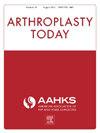Clinical Outcomes and Overall Satisfaction of Patents Enrolled in an Artificial Intelligence–Powered Chatbot Following Periacetabular Osteotomy
IF 2.1
Q3 ORTHOPEDICS
引用次数: 0
Abstract
Background
The role of technology in the perioperative care of patients continues to grow. A surgeon-specific perioperative chatbot may improve the care of patients by answering questions or concerns. The purpose of this retrospective review was to assess if enrollment in a perioperative chatbot was associated with differences in clinical outcomes or patient satisfaction following periacetabular osteotomy.
Methods
We identified 62 patients who enrolled in a short message service (SMS) chatbot from December 1, 2020 to August 1, 2023. A consecutive historical cohort of 64 patients from August 1, 2018 to November 30, 2020 was identified for comparative purposes. Descriptive statistics were used to compare demographic differences between patients enrolled vs not enrolled in the chatbot. Independent t-tests, Fischer’s exact tests, and chi-squared tests were also used for comparative purposes.
Results
Patients who were enrolled in a perioperative SMS-based chatbot requested significantly fewer narcotic refills (P = .0001). There were also significantly fewer clinic calls placed for patients enrolled in the chatbot compared to those not enrolled (1.1 calls vs 3.3 calls, P < .0001). There were no significant differences in emergency department visits or readmissions within 90 days of surgery, reoperations, or infections. Patients enrolled in a perioperative chatbot had significantly higher satisfaction compared to those not enrolled (4.7 vs 4.3, P = .039).
Conclusions
Enrollment in an SMS-based perioperative chatbot for patients undergoing periacetabular osteotomy was associated with fewer narcotic refills, fewer telephone calls to clinic, and increased patient satisfaction compared to a historical cohort not enrolled perioperative chatbot.
髋臼周围截骨术后人工智能聊天机器人注册专利的临床结果和总体满意度
技术在患者围手术期护理中的作用不断增强。外科手术专用的围手术期聊天机器人可以通过回答问题或担忧来改善对患者的护理。本回顾性研究的目的是评估入选围手术期聊天机器人是否与髋臼周围截骨术后临床结果或患者满意度的差异有关。方法选取2020年12月1日至2023年8月1日注册短信聊天机器人的62例患者。2018年8月1日至2020年11月30日的64例患者的连续历史队列被确定为比较目的。描述性统计用于比较加入与未加入聊天机器人的患者之间的人口统计学差异。独立t检验、Fischer精确检验和卡方检验也用于比较目的。结果围手术期使用短信聊天机器人的患者需要的麻醉药品补剂明显减少(P = 0.0001)。与未注册的患者相比,注册聊天机器人的患者的门诊电话也明显减少(1.1个电话对3.3个电话,P <;。)。手术、再手术或感染后90天内急诊就诊或再入院率无显著差异。参加围手术期聊天机器人的患者满意度明显高于未参加的患者(4.7 vs 4.3, P = 0.039)。结论:与未入组的历史队列相比,在髋臼周围截骨术患者的围手术期聊天机器人中使用基于sms的聊天机器人可以减少麻醉药品的再次使用,减少临床电话,并提高患者满意度。
本文章由计算机程序翻译,如有差异,请以英文原文为准。
求助全文
约1分钟内获得全文
求助全文
来源期刊

Arthroplasty Today
Medicine-Surgery
CiteScore
2.90
自引率
0.00%
发文量
258
审稿时长
40 weeks
期刊介绍:
Arthroplasty Today is a companion journal to the Journal of Arthroplasty. The journal Arthroplasty Today brings together the clinical and scientific foundations for joint replacement of the hip and knee in an open-access, online format. Arthroplasty Today solicits manuscripts of the highest quality from all areas of scientific endeavor that relate to joint replacement or the treatment of its complications, including those dealing with patient outcomes, economic and policy issues, prosthetic design, biomechanics, biomaterials, and biologic response to arthroplasty. The journal focuses on case reports. It is the purpose of Arthroplasty Today to present material to practicing orthopaedic surgeons that will keep them abreast of developments in the field, prove useful in the care of patients, and aid in understanding the scientific foundation of this subspecialty area of joint replacement. The international members of the Editorial Board provide a worldwide perspective for the journal''s area of interest. Their participation ensures that each issue of Arthroplasty Today provides the reader with timely, peer-reviewed articles of the highest quality.
 求助内容:
求助内容: 应助结果提醒方式:
应助结果提醒方式:


